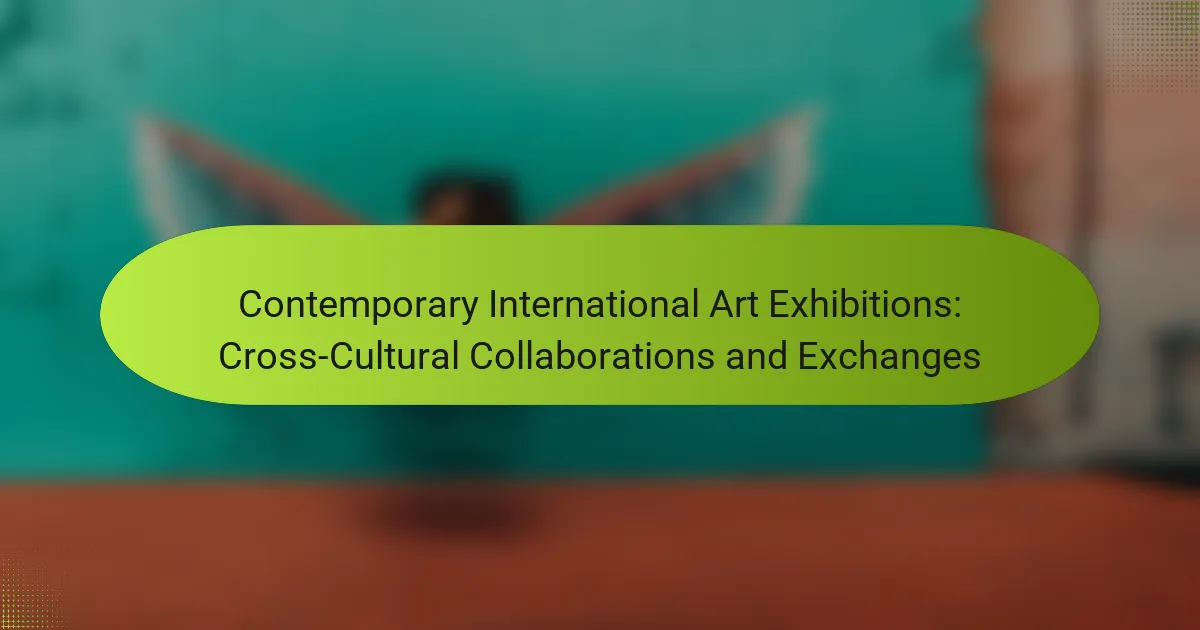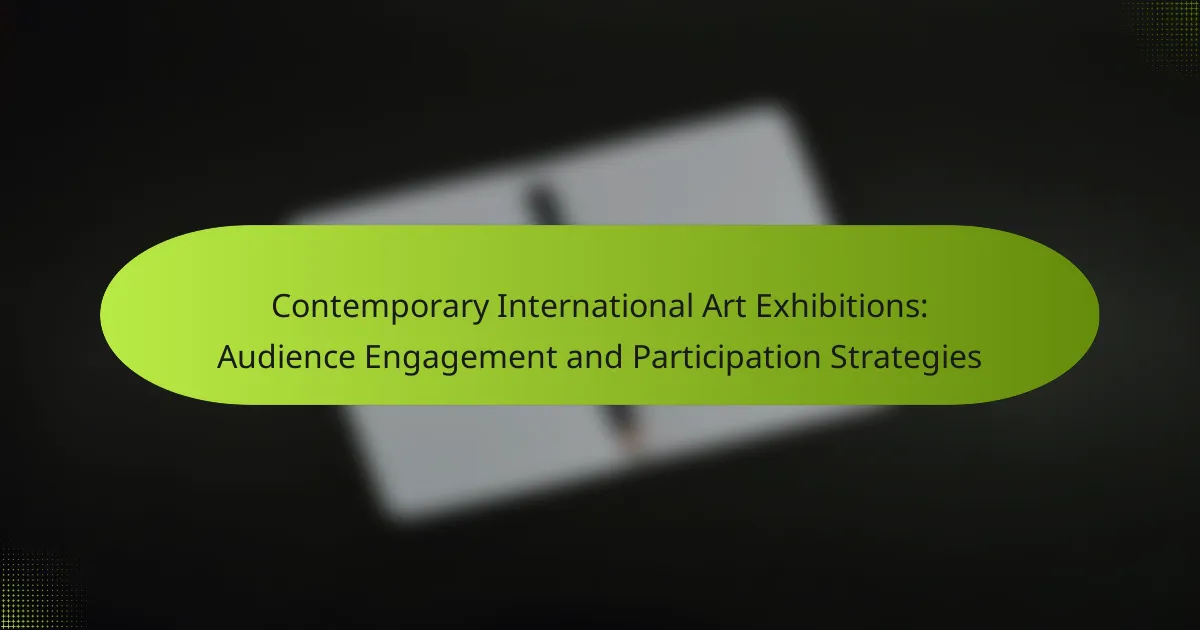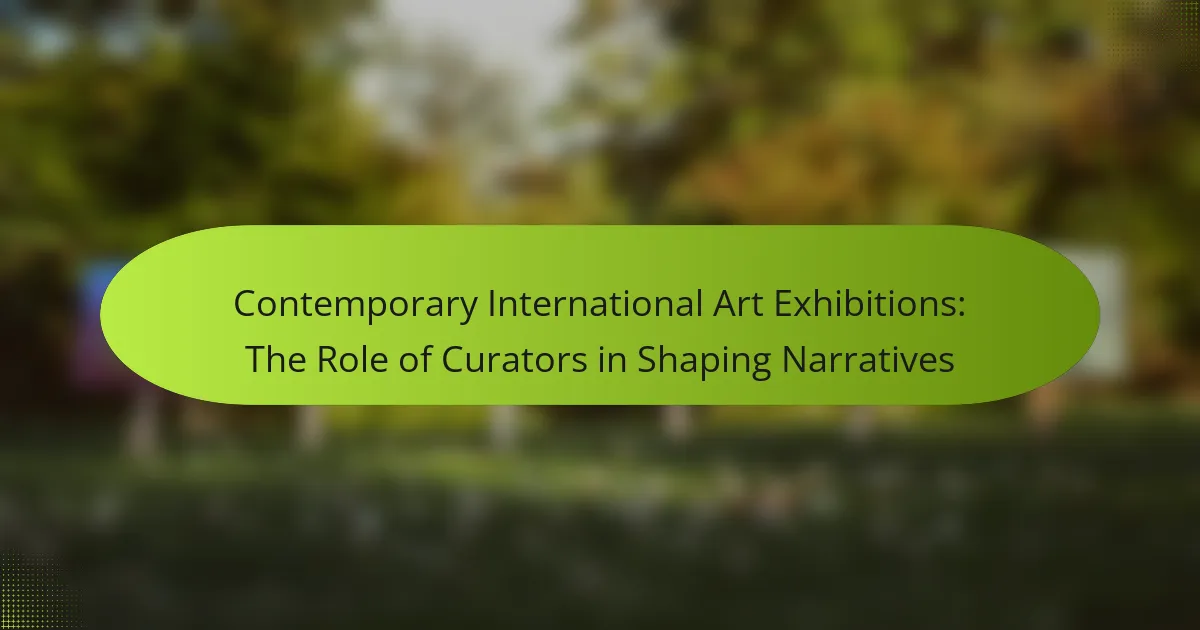Contemporary international art exhibitions play a crucial role in transforming the global art landscape. They foster dialogue and collaboration among diverse artists, highlighting themes of identity and social justice. Historical movements like Modernism and the Feminist Art Movement have shaped their evolution, influencing representation and inclusivity. Key platforms such as the Venice Biennale and Art Basel showcase innovative works, reflecting cultural narratives and challenging traditional artistic boundaries.
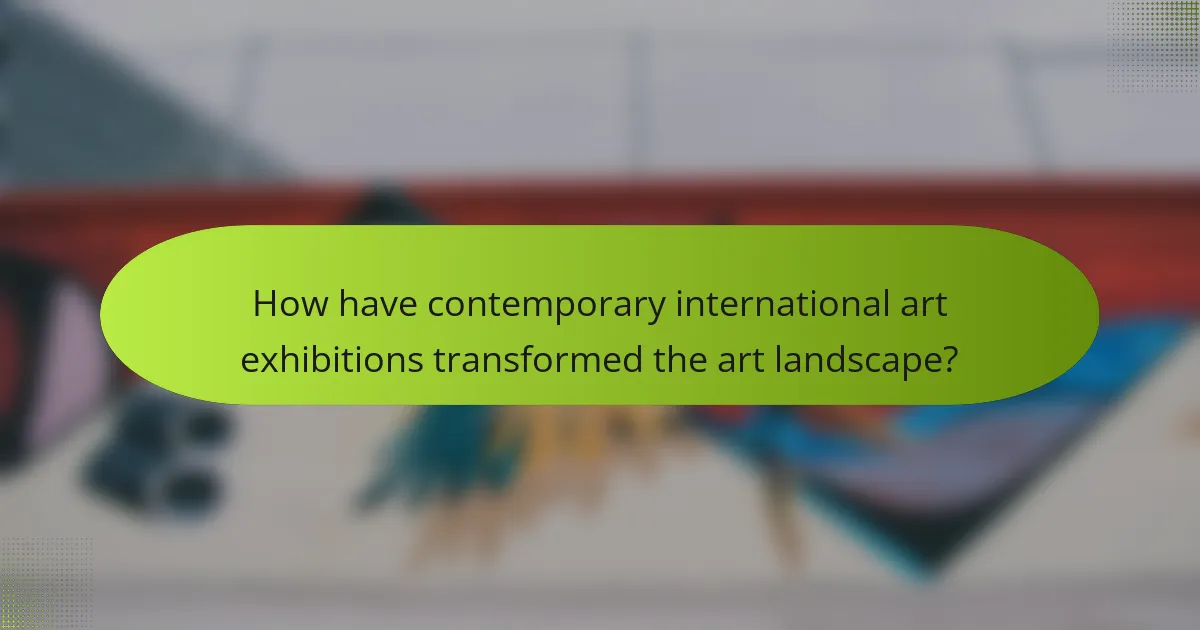
How have contemporary international art exhibitions transformed the art landscape?
Contemporary international art exhibitions have significantly transformed the art landscape by fostering global dialogue and collaboration. They provide platforms for diverse artists, enhancing visibility and accessibility. These exhibitions often highlight unique attributes of contemporary art, such as multimedia integration and social engagement. As a result, they challenge traditional art norms and influence cultural perceptions worldwide.
What role do major art fairs play in shaping contemporary art trends?
Major art fairs significantly influence contemporary art trends by providing platforms for emerging artists and new ideas. They facilitate networking among artists, collectors, and curators, shaping market dynamics and aesthetic directions. Events like Art Basel and Frieze showcase diverse styles, driving public interest and critical discourse. Additionally, these fairs often set trends in art consumption, impacting how art is marketed and valued in the global landscape.
Which factors influence the selection of artworks for international exhibitions?
Artworks for international exhibitions are influenced by cultural relevance, artistic innovation, and curatorial vision. Selection often considers the historical context of the artworks and their connection to contemporary issues. Factors such as audience engagement and diversity of perspectives also play crucial roles. Additionally, the reputation of the artist and the significance of the exhibition venue can impact choices.

What historical movements have influenced contemporary art exhibitions?
Historical movements such as Modernism, Postmodernism, and the Feminist Art Movement have significantly influenced contemporary art exhibitions. Modernism introduced abstraction and challenged traditional forms, while Postmodernism questioned established narratives and embraced diversity. The Feminist Art Movement highlighted gender issues, reshaping representation in art. These movements fostered experimentation and inclusivity, shaping the evolution of contemporary art spaces globally.
How did the post-war era redefine the concept of art exhibitions?
The post-war era redefined art exhibitions by emphasizing inclusivity and global perspectives. This period marked a shift from traditional, Eurocentric displays to diverse representations of contemporary art. International exhibitions became platforms for artists from various backgrounds, showcasing unique cultural narratives. The Venice Biennale and Documenta exemplify this evolution, highlighting the integration of political and social themes in art. As a result, exhibitions now serve as critical dialogues on identity and society, reflecting a broader understanding of contemporary artistic expression.
What impact did the rise of globalization have on contemporary art practices?
The rise of globalization significantly transformed contemporary art practices by fostering cross-cultural exchanges. Artists now draw inspiration from diverse traditions, leading to innovative forms and themes. Global platforms like the Venice Biennale showcase this evolution, highlighting the interconnectedness of art worldwide. As a result, contemporary art reflects a fusion of local and global narratives, breaking traditional boundaries and expanding audience engagement.
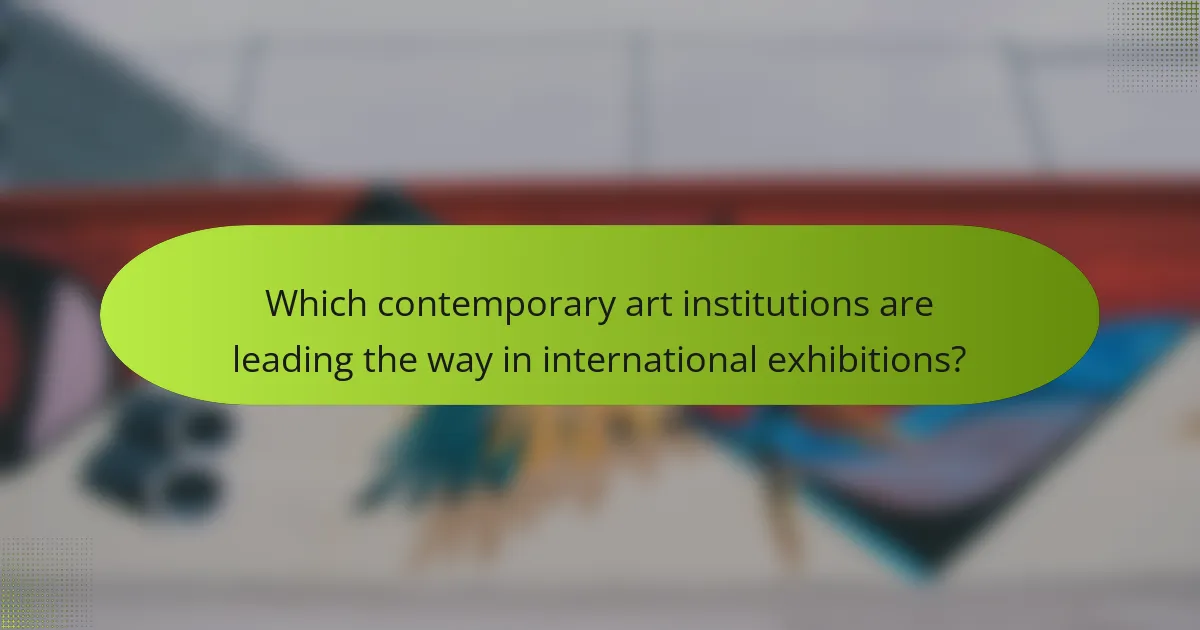
Which contemporary art institutions are leading the way in international exhibitions?
Leading contemporary art institutions for international exhibitions include the Venice Biennale, Documenta, Art Basel, and the Museum of Modern Art (MoMA). These institutions showcase innovative works and influence global art trends. The Venice Biennale, established in 1895, remains a pivotal platform for contemporary artists. Documenta, held every five years in Kassel, Germany, emphasizes critical engagement with art and society. Art Basel, with locations in Switzerland, Miami, and Hong Kong, connects galleries and collectors worldwide. MoMA, in New York City, is renowned for its extensive collection and exhibitions that highlight contemporary movements.
How do museums and galleries curate exhibitions to reflect cultural diversity?
Museums and galleries curate exhibitions to reflect cultural diversity by showcasing a variety of artists and perspectives. They prioritize inclusivity in selection processes, ensuring representation from different cultural backgrounds.
Exhibition themes often focus on multicultural narratives, highlighting historical contexts that have shaped contemporary art. For instance, many institutions collaborate with local communities to gather insights and artworks that resonate with diverse experiences.
Curators utilize educational programs and outreach initiatives to engage audiences from various demographics. This approach fosters a deeper understanding of the cultural significance behind the artworks displayed.
Additionally, the integration of technology enhances accessibility, allowing broader audiences to experience exhibitions virtually. This method supports the mission of promoting cultural diversity in the art world.
What are the challenges faced by emerging artists in international exhibitions?
Emerging artists face significant challenges in international exhibitions, including limited visibility, financial constraints, and cultural barriers. They often struggle to gain recognition in a competitive environment dominated by established artists. Financial limitations can hinder their ability to participate in costly exhibitions or travel. Additionally, navigating different cultural contexts and expectations can complicate their presentation and acceptance. These factors can impede their growth and opportunities in the global art scene.
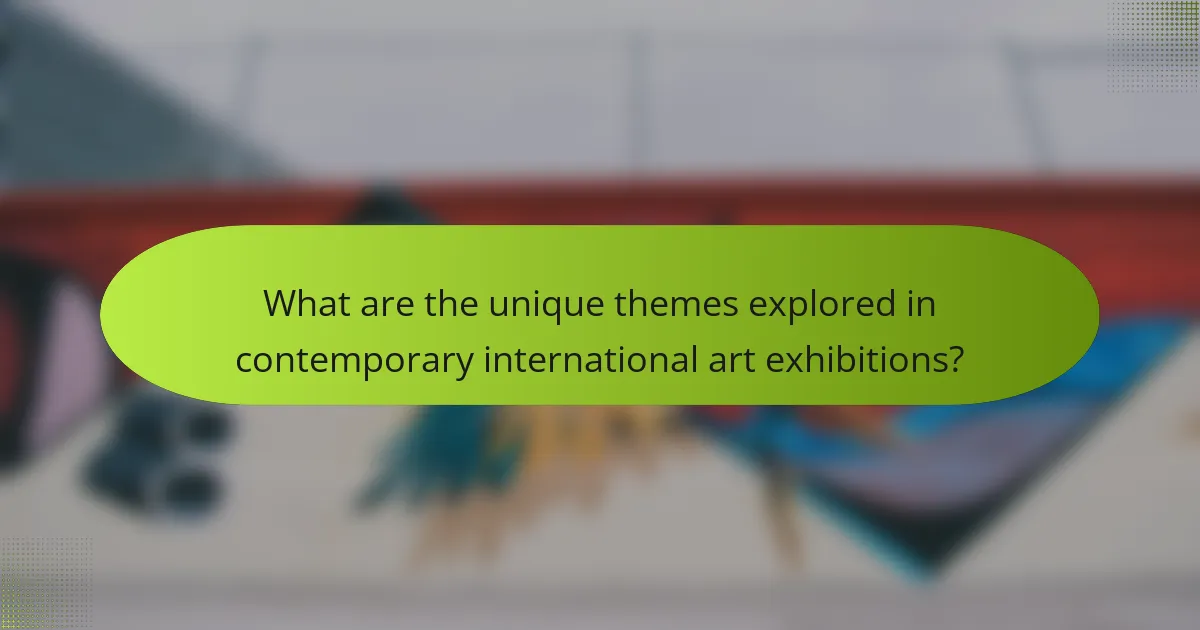
What are the unique themes explored in contemporary international art exhibitions?
Contemporary international art exhibitions explore themes of identity, globalization, and social justice. They reflect cultural narratives and challenge traditional artistic boundaries. Artists engage with technology and environmental issues, emphasizing sustainability and community. These exhibitions often serve as platforms for underrepresented voices, fostering dialogue and inclusivity.
How do social and political issues manifest in contemporary art displays?
Social and political issues manifest in contemporary art displays through provocative themes, diverse mediums, and participatory installations. Artists often address topics like inequality, identity, and environmental concerns, reflecting societal tensions. For example, exhibitions may feature works that critique government policies or highlight marginalized voices. This evolution of contemporary art showcases its role as a platform for dialogue and social change. The integration of technology further amplifies these themes, enabling immersive experiences that engage audiences on multiple levels.
Which innovative formats are being used in contemporary art exhibitions?
Contemporary art exhibitions increasingly utilize innovative formats to engage audiences. These formats include immersive installations, virtual reality experiences, and interactive multimedia displays.
Immersive installations often transform gallery spaces, allowing viewers to become part of the artwork. Virtual reality experiences provide a unique, personal interaction with art, enabling exploration of digital realms. Interactive multimedia displays encourage audience participation, fostering a dialogue between the art and its viewers.
These innovative approaches not only enhance the viewer’s experience but also reflect the evolving nature of contemporary art, emphasizing engagement and interactivity.
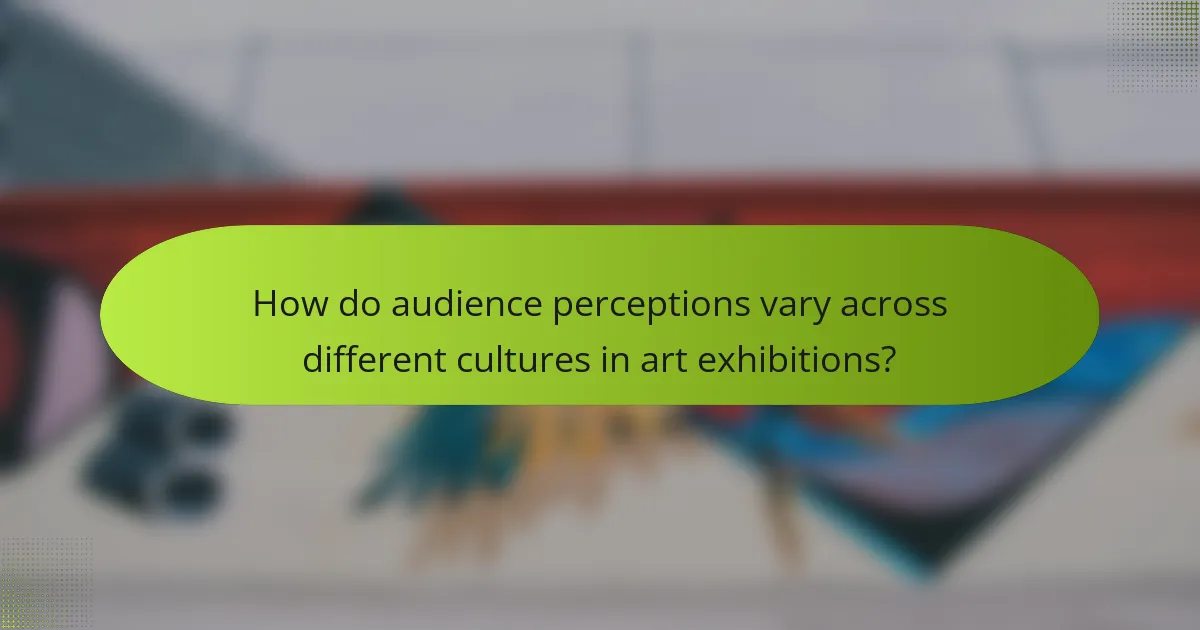
How do audience perceptions vary across different cultures in art exhibitions?
Audience perceptions of art exhibitions differ significantly across cultures due to varying historical contexts, values, and artistic traditions. Cultural background shapes how individuals interpret contemporary art, influencing their emotional responses and engagement levels. For instance, Western audiences may prioritize individual expression, while Eastern cultures might emphasize collective narratives. This divergence can lead to contrasting interpretations of the same artwork, reflecting unique cultural lenses. Additionally, the evolution of contemporary art has introduced diverse styles and themes, further complicating audience perceptions globally. Understanding these cultural nuances is essential for curators aiming to create inclusive and resonant exhibitions.
What role does technology play in enhancing visitor engagement at art exhibitions?
Technology significantly enhances visitor engagement at art exhibitions by providing interactive experiences and personalized content. Digital tools, such as augmented reality, allow visitors to immerse themselves in artworks, creating a dynamic connection. Additionally, mobile apps can offer tailored information based on user preferences, enriching the overall experience. Data analytics helps curators understand visitor behavior, allowing for improved exhibition layouts and targeted marketing strategies. As a result, technology not only attracts more visitors but also deepens their appreciation of contemporary art.
How do art critics influence the reception of contemporary art exhibitions?
Art critics significantly shape the reception of contemporary art exhibitions by providing context, analysis, and interpretation. Their reviews can elevate an artist’s profile, influencing public perception and attendance. Critics often highlight unique attributes of artworks, such as innovative techniques or thematic depth, which can spark interest and debate. Additionally, their critiques can create a narrative around an exhibition, framing it within historical and cultural contexts, thus enhancing its significance. This influence is particularly evident in major international exhibitions, where critics’ opinions can sway collectors, curators, and the art community at large.
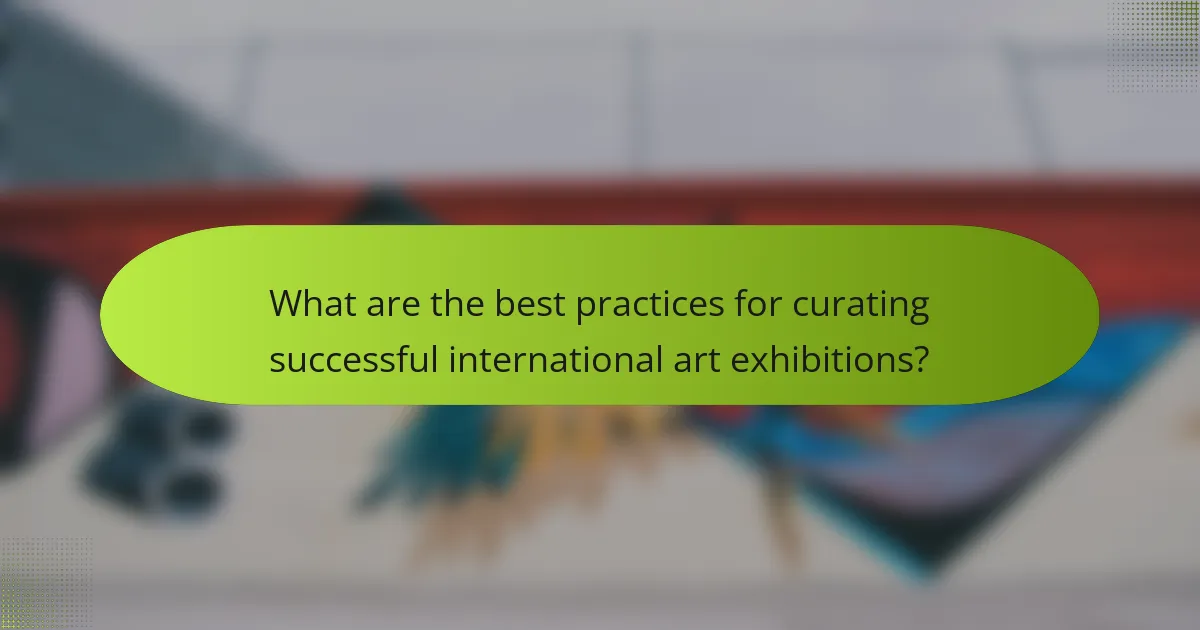
What are the best practices for curating successful international art exhibitions?
Effective practices for curating successful international art exhibitions involve strategic planning and audience engagement. Curators should emphasize cultural relevance, ensuring the selected artworks resonate with diverse audiences. Collaboration with local artists and institutions enhances authenticity and fosters community connection.
Additionally, leveraging technology for virtual tours and interactive installations can broaden accessibility. Curators must prioritize sustainability, considering the environmental impact of exhibitions. Engaging narratives around the artworks can deepen visitor understanding and appreciation.
Finally, continuous evaluation and feedback collection post-exhibition can inform future endeavors, ensuring growth and adaptation in the evolving art landscape.
Which common mistakes should curators avoid when planning exhibitions?
Curators should avoid several common mistakes when planning contemporary international art exhibitions. Failing to research historical context can lead to a lack of depth. Neglecting audience engagement results in diminished attendance. Overlooking logistics, such as installation timelines and budget constraints, can derail the project. Additionally, ignoring the importance of diverse perspectives may limit the exhibition’s relevance. Finally, not evaluating past exhibitions can prevent learning from previous successes or failures.
How can collaboration between artists and curators enhance exhibition outcomes?
Collaboration between artists and curators significantly enhances exhibition outcomes by fostering creativity and broadening perspectives. Artists bring unique visions, while curators provide context and structure. This synergy results in more engaging and cohesive exhibitions.
For example, when artists and curators collaborate, they can create thematic narratives that resonate with audiences. Curators can help artists refine their concepts, while artists can inspire curators to explore innovative display methods. This partnership often leads to exhibitions that are not only visually stunning but also intellectually stimulating.
Additionally, collaborative efforts can attract diverse audiences. By integrating various artistic styles and cultural backgrounds, exhibitions become more inclusive and representative of contemporary global art trends. This inclusivity enhances the overall impact and reach of the exhibition.
Ultimately, the collaboration between artists and curators is essential in evolving the exhibition landscape, ensuring that contemporary art remains dynamic and relevant.
